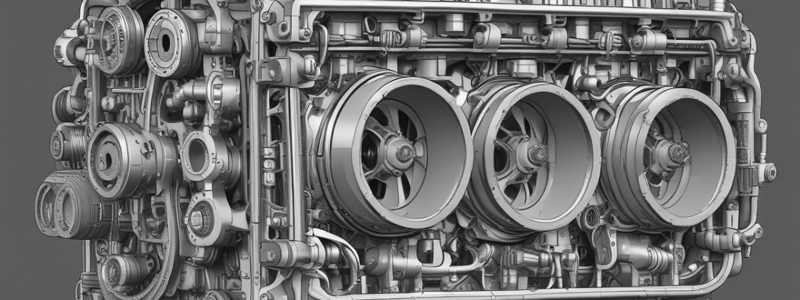Podcast
Questions and Answers
What is the primary function of the engine cylinder block?
What is the primary function of the engine cylinder block?
- To transfer heat to the cooling system
- To generate power for the vehicle's accessories
- To compress air for fuel injection
- To provide a rigid foundation for engine components (correct)
What components are mounted to the cylinder block?
What components are mounted to the cylinder block?
- Alternator, starter motor, and power steering pump
- Crankshaft, camshaft, and pistons
- Cylinder head, flywheel housing, and oil pan
- Engine fuel system and lubrication system components (correct)
What is contained within the cylinder block?
What is contained within the cylinder block?
- Pistons, connecting rods, and crankshaft
- Valves, springs, and oil pump
- Crankshaft main bearing bores, camshaft bearing bores, and cylinders (correct)
- Air compressor, alternator, and starter motor
What is the purpose of the main bearing webs and bulkheads in the cylinder block?
What is the purpose of the main bearing webs and bulkheads in the cylinder block?
What is the underside of an in-line cylinder block commonly referred to as?
What is the underside of an in-line cylinder block commonly referred to as?
What forces are transferred from the pistons and connecting rods to the crankshaft?
What forces are transferred from the pistons and connecting rods to the crankshaft?
What is the primary purpose of the expansion plugs in a cylinder block?
What is the primary purpose of the expansion plugs in a cylinder block?
What is the typical location of cylinder numbering on an in-line engine block?
What is the typical location of cylinder numbering on an in-line engine block?
What is the purpose of the threaded plugs in a cylinder block?
What is the purpose of the threaded plugs in a cylinder block?
In a V-type engine, how are the banks typically indicated?
In a V-type engine, how are the banks typically indicated?
What should be consulted for a description and location of passages in a cylinder block?
What should be consulted for a description and location of passages in a cylinder block?
What is the main reason for removing expansion and threaded plugs during major engine overhaul?
What is the main reason for removing expansion and threaded plugs during major engine overhaul?
Flashcards are hidden until you start studying
Study Notes
Engine Cylinder Block Overview
- Acts as a rigid foundation for major engine components.
- Provides mounting points for fuel, lubrication, and cooling systems, along with accessories like air compressors, alternators, and power steering pumps.
Structure and Design
- Houses crankshaft main bearing bores, camshaft bearing bores, and cylinders (either integral or replaceable).
- Requires machined surfaces for mounting external components such as cylinder heads, flywheel housing, front gear cover, and oil pan.
Force Management
- Transfers combustion forces from pistons and connecting rods to the crankshaft.
- Main bearing bores sustain the crankshaft against these forces, reinforced by main bearing webs and bulkheads for added strength.
Coolant and Lubrication Passages
- Contains passages and galleries facilitating the flow of coolant and lubricating oil throughout the engine.
- Features oil passages that lubricate crankshaft main bearings; ensures efficient operation and longevity of engine parts.
Expansion and Threaded Plugs
- Equipped with expansion (core) plugs to seal openings from the manufacturing process, preventing block cracking during freezing conditions.
- Threaded plugs provide access for cleaning oil and coolant passages during a major engine overhaul.
Cylinder Configuration and Numbering
- Cylinders can be integral or replaceable and are arranged based on engine design.
- Typical numbering starts from the front of the engine; instructions may vary by manufacturer.
- In V-type engines, banks are designated as left or right from the rear, with specific conventions for numbering each cylinder.
Manufacturer’s Service Manual
- Given the variety in cylinder block designs, always refer to the manufacturer’s service manual for precise information regarding cylinder locations and numbering.
Studying That Suits You
Use AI to generate personalized quizzes and flashcards to suit your learning preferences.




